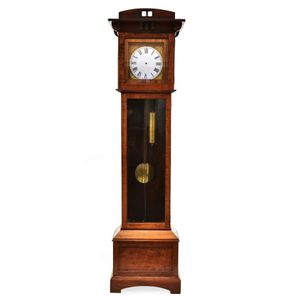J.W. Benson Mahogany Long Case Clock, 1865
You must be a subscriber, and be logged in to view price and dealer details.
Subscribe Now to view actual auction price for this item
When you subscribe, you have the option of setting the currency in which to display prices to $Au, $US, $NZ or Stg.
- Mahogany - Mahogany is a dense, close grained red-coloured timber from the West Indies and Central America. It was first imported into Europe in the the early 18th century and its use continued through the 19th century. It was popular for furniture making because of its strength, the wide boards available, the distinctive grain on some boards, termed flame mahogany and the rich warm colour of the timber when it was polished.. The "flame" was produced where a limb grew out from the trunk of the tree, and this timber was usually sliced into veneers for feature panels on doors, backs and cornices.
Some terms used to describe mahogany relate to the country from which it originally came, such as "Cuban" mahogany, "Honduras" mahogany etc. However unless the wood has been tested the names assigned are more a selling feature, rather than a true indication of the timber's origin. - Circa - A Latin term meaning 'about', often used in the antique trade to give an approximate date for the piece, usually considered to be five years on either side of the circa year. Thus, circa 1900 means the piece was made about 1900, probably between 1895 and 1905. The expression is sometimes abbreviated to c.1900.
- Anchor Escapement - An anchor escapement is a type of mechanical escapement used in clocks and watches. It is a refinement of the older verge escapement, which was used in early mechanical timekeeping devices. The anchor escapement is characterised by the use of an anchor-shaped pallet that rocks back and forth, alternately locking and releasing the escape wheel. This action allows the movement of the watch or clock to be regulated, producing the characteristic tick-tock sound that is associated with mechanical timekeeping devices. The anchor escapement is generally more accurate and reliable than the verge escapement, and it is still used in many modern clocks and watches today.
- Movement - The technical name for the workings of a clock or watch, and does not include the dial or case.
This item has been included into following indexes:
Visually similar items

A longcase clock with a fiddleback blackwood case, the Arts & Crafts inspired case, with a rectangular glazed door enclosing a circular dial with Roman numerals, (dial hands loose) 197 cm high

A George II mahogany longcase clock, Skeleton Barrett, London, circa 1740 8-day, silent/strike, five pillar movement with anchor escapements and rack striking on a bell, brass dial with silvered chapter ring, Roman numerals, and rococo spandrels, matted br

A George III oak longcase clock by J. Thomas of Chester, the hood with plain tapered columns, the upper arch with carved and fret leaf scroll and floral design, the engraved silvered dial with roman numerals, subsidiary seconds, date aperture, the cross-ba

A mid 18th century longcase thirty hour clock in repolished quarter sawn solid oak case. Bell strike. Brass face with silvered chapter ring and gilt scroll spandrels by Thomas West. C.1770, listed as working in Reading 1762-1780. Height 192 cm
